What is Leptospirosis?
Leptospirosis is a bacterial infection that can affect both people and animals. It is caused by bacteria called Leptospira. Often, people get leptospirosis after contact with water, soil, or food contaminated by the urine of infected animals. This disease is more common in warm, wet areas. However, it can happen anywhere. Early detection and treatment are very important for a good recovery.
Symptoms of Leptospirosis
Leptospirosis symptoms can vary from mild to severe. Sometimes, symptoms may not appear at all. But, when they do, they often start suddenly. Common signs include:High feverHeadacheChillsMuscle aches, especially in the legs and backRed eyesVomiting or nauseaDiarrheaRashYellow skin or eyes (jaundice)
Sometimes, symptoms return after a short break. This second phase can be more serious. For example, it may cause kidney or liver problems. If you notice these signs, seek medical help right away.
Causes and Risk Factors
Leptospirosis is caused by Leptospira bacteria. These bacteria live in the urine of infected animals, such as rats, dogs, cattle, and pigs. People can get infected when they touch water or soil with the bacteria. For instance, swimming in lakes or rivers after heavy rain can increase your risk. Other risk factors include:Working with animals (farmers, veterinarians)Living in areas with poor sanitationOutdoor activities like camping or hikingFlooding or heavy rainfall
Although anyone can get leptospirosis, people in tropical or rainy regions face higher risks. Taking simple steps can help lower your chances of infection.
How Leptospirosis is Diagnosed
Doctors use several methods to diagnose leptospirosis. First, they ask about your symptoms and recent activities. For example, they may ask if you have been near animals or floodwater. Next, they may order tests such as:Blood tests to look for signs of infectionUrine tests to detect the bacteriaSpecial tests to find antibodies against Leptospira
Because symptoms can look like other illnesses, it is important to tell your doctor about any possible exposure. Early diagnosis helps prevent serious problems.
Treatment Options
Leptospirosis is usually treated with antibiotics. For mild cases, doctors often prescribe medicines like doxycycline or penicillin. Most people recover fully with early treatment. However, severe cases may need hospital care. In these cases, patients may receive fluids, oxygen, or other support. It is important to finish all prescribed medicine, even if you feel better. This helps prevent the infection from coming back.
Prevention Tips and Lifestyle Guidance
There are many ways to lower your risk of leptospirosis. Here are some helpful tips:Avoid swimming or wading in water that may be dirty or contaminatedWear protective clothing and shoes when working outdoorsWash hands well after touching animals or soilKeep food and water covered to prevent animal contactControl rodents around your home and workplaceClean and cover any cuts or wounds
In some cases, doctors may suggest preventive antibiotics for people at high risk. However, these are not needed for everyone. Good hygiene and safe habits are the best ways to stay healthy.
When to Seek Medical Help
If you have symptoms of leptospirosis, see a doctor as soon as possible. This is especially important if you have a high fever, yellow skin, or severe pain. Early treatment can prevent serious health problems. Even if your symptoms are mild, it is better to be safe. Always tell your doctor about any recent travel, outdoor activities, or contact with animals.
In summary, leptospirosis is a serious but treatable infection. Knowing the symptoms, causes, and prevention steps can help you stay safe. If you think you may have leptospirosis, consult your healthcare provider for advice and care tailored to your needs.

